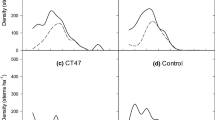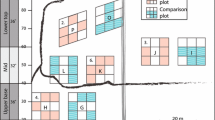Abstract
Forest landowners in the southeastern United States have the opportunity to manage their loblolly, longleaf and slash pine stands for pine straw (fresh undecomposed needles; the litter layer) for non-timber revenues. Pine straw is used primarily as mulch in landscaping and has grown in revenues paid to landowners in Georgia from $15.5 million in 1999 to $81 million in 2009. Pine straw is typically sold by the acre or by the bale. Selling pine straw by the acre may be advantageous to absentee landowners. Selling pine straw by the bale can generate more annual income, but bale counts need to be accurate and bale dimensions defined. For both methods, recent (2005–2010) pine straw multi-year revenues range from $50 to $150 per acre annually. Longleaf pine straw commands the highest price per bale, followed by slash pine, and lastly loblolly pine. Per rake yields from loblolly stands tend to be 15–30 % greater than slash and longleaf pine. Pine straw raking typically starts at canopy closure continuing to the first thinning, generating from $300 per acre to over $1000 per acre in new income. This paper summarizes pine straw yields and economics in loblolly, longleaf, and slash pine stands.
Similar content being viewed by others
References
Boatright SR, McKissick JC (2000–2010) 1999–2009 Georgia Farm Gate Value Reports. AR-00-01 through AR-10-01. Center for Agribusiness and Economic Development, College of Agricultural and Environmental Sciences, UGA, Athens, GA, pp 175
Dickens ED (2000) Sand hills state forest: town of Cheraw lime stabilized biosolids and inorganic fertilizer application in longleaf stands: four year summary report, pp 25
Dickens ED, McElvany BC, Irwin KM, Wynne TL (2005) Fertilization of unthinned loblolly pine on an intensively prepared cut-over site in Twiggs County, Georgia: four year results. www.bugwood.org/productivity.html, pp 8
Dickens ED, Dangerfield CW, Moorhead DJ (2007) Economics of growing slash and loblolly pine to a 24-year rotation with and without thinning, fertilization, and pine straw: net revenue and rate of return. Series Paper #1. www.forestproductivity.net, pp 14
Dickens ED, Moorhead DJ, Hicks R, McElvany BC (2010) Longleaf pine growth and economics on old-field planted sites in Georgia: results through age 21-years. In: SOFEW Proceedings. Mississippi State University, Starkville, MS, pp 5
Dickens ED, Moorhead DJ, Kissel DE, Morris LA (2010). Mid-rotation rate of return estimates with a single NP or NPK fertilizer application in loblolly, longleaf, and slash pine stands. http://www.forestproductivity.net/fertilization/ror_estimates_sept_2010.pdf
Gholz HL, Perry CS, Cropper WP, Hendry LC (1985) Litterfall decomposition and nitrogen and phosphorus dynamics in a chronosequence of slash pine (Pinus elliottii) plantations. Forensic Sci 31:463–478
Hayes MD, McElvany BC, Dickens ED, Moorhead DJ (2009) Intensive pine straw management on post CRP pine stands. www.bugwood.org/productivity.html, pp 4
Morris LA, Jokela EJ, O-Connor Jr JB (1992) Silvicultural guidelines for pinestraw management in the southeastern United States. Georgia Forest Res. Paper #88. Georgia Forestry Commission, Macon, GA, pp 11
Ogden EA, Morris LA (2004) Effects of annual pine straw removal and mid-rotation fertilization on pine growth in unthinned plantations. In: Dickens ED, Barnett JP, Hubbard WG, Jokela EJ (eds) Slash pine: still growing and growing. In: Proceedings of the slash pine symposium. GTR SRS-076. Asheville, NC: USDA, FS, SRS, pp 90–95
SAS Institute, Inc. (1987) SAS/STAT guide for personal computers, version, 6th edition. SAS Institute, Inc. Cary, NC
Author information
Authors and Affiliations
Corresponding author
Rights and permissions
About this article
Cite this article
Dickens, E.D., Moorhead, D.J., Bargeron, C.T. et al. A summary of pine straw yields and economic benefits in loblolly, longleaf and slash pine stands. Agroforest Syst 86, 315–321 (2012). https://doi.org/10.1007/s10457-012-9542-4
Received:
Accepted:
Published:
Issue Date:
DOI: https://doi.org/10.1007/s10457-012-9542-4




